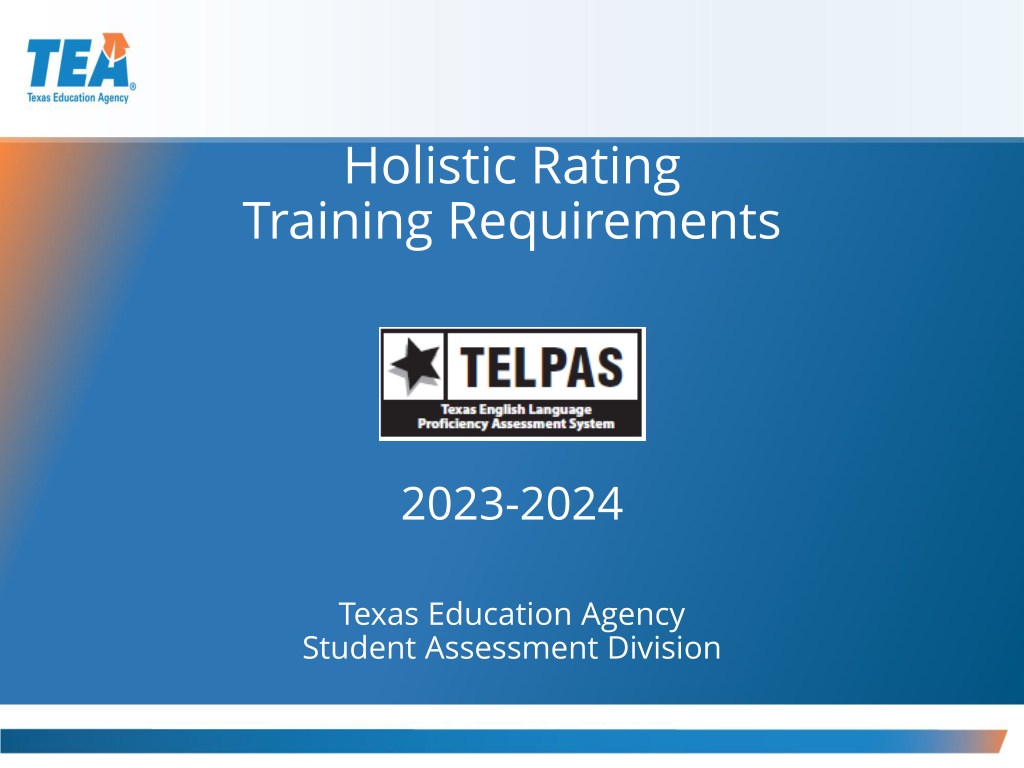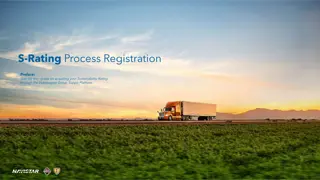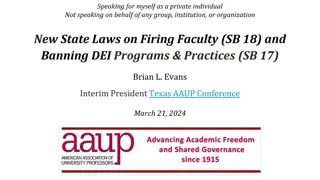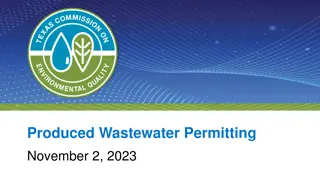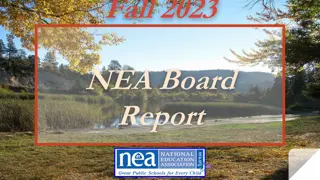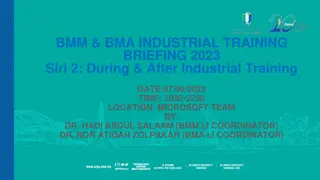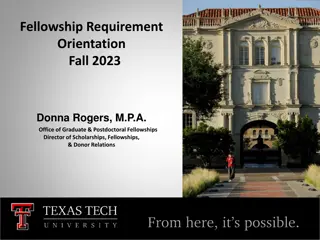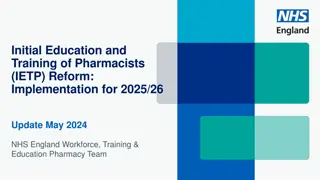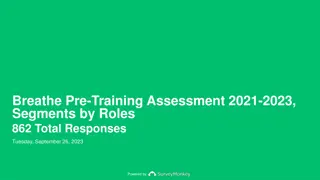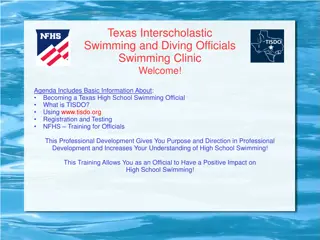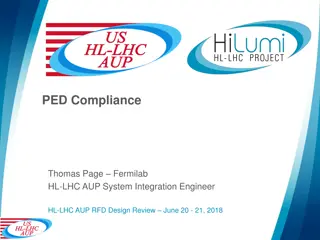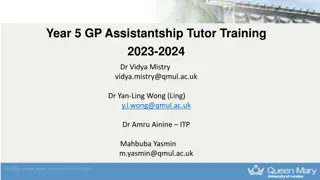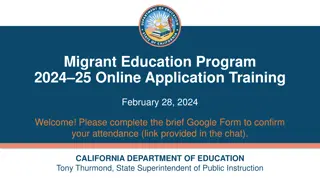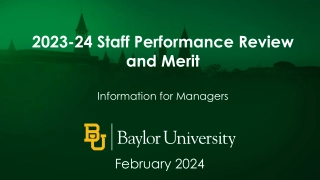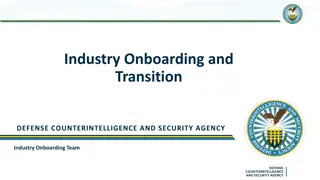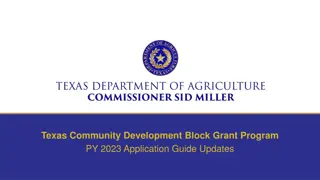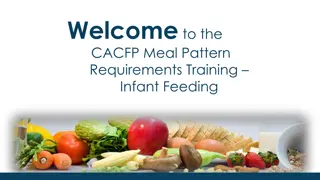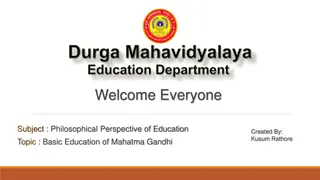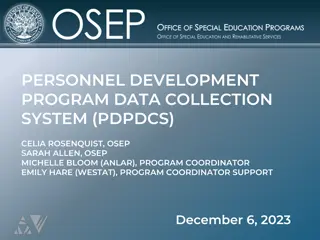Holistic Rating Training Requirements 2023-2024 by Texas Education Agency
Holistic Rating Training Requirements for TELPAS components for grades K-12 in Texas include calibration, basic training, and responsibilities for raters. Raters and verifiers are educators assigned to rate students eligible for special holistic administrations. Rater credentials mandate valid Texas education credentials and appropriate training.
Download Presentation
Please find below an Image/Link to download the presentation.
The content on the website is provided AS IS for your information and personal use only. It may not be sold, licensed, or shared on other websites without obtaining consent from the author. Download presentation by click this link. If you encounter any issues during the download, it is possible that the publisher has removed the file from their server.
Presentation Transcript
Holistic Rating Training Requirements 2023-2024 Texas Education Agency Student Assessment Division
Topics TELPAS Components TELPAS Raters Credentials Responsibilities New & returning rater definitions Holistic Rating Training Overview Training requirements Basic training Calibration 2
TELPAS Components Grades 2 12 Grades K 1* Holistically-rated Assessments Online Tests Listening Speaking Listening and Speaking Writing Reading Reading and Writing TEA 3
Raters and TELPAS Online Tests There are two online tests for grades 2-12: listening and speaking test and reading and writing test. If a student is eligible for a special administration in one of the test s domains, the student will need to have a special administration in both domains (if applicable). For the listening, speaking, and writing domains, a special holistic administration will be completed by trained raters that have been assigned students that are eligible for a special administration in those domains. For the reading domain, a special administration is a paper test (regular print, large print, or braille) which will require a trained test administrator to administer the test. TEA 4
TELPAS 2-12 Raters and Verifiers Are educators that have been assigned to rate students eligible for a special holistic administration (listening, speaking, and/or writing) Raters Will need to rate students in all the applicable domains (listening, speaking, and/or writing) Verifiers Will be needed to verify writing collections of students that will have a special holistic administration in the writing domain. 5
Rater Credentials A teacher (including a substitute teacher) selected to rate an emergent bilingual (EB) student must have the student in class at the time of the spring assessment window, be knowledgeable about the student s ability to use English in instructional and informal settings, hold valid Texas education credentials, such as a teacher certificate or permit, be appropriately trained in the holistic rating process, and rate the student in all eligible domains. There is no longer a distinction between K-1 and 2-12 raters. 6
TELPAS Rater Responsibilities A student s TELPAS rater is the person designated by the district as the official rater of the student s English language proficiency. A rater must rate the student in all domains for which the student is eligible. It is not permitted for a student to have one rater for some domains and another rater for other domains. 7
New Raters: K1 and 212 Training Requirements NEW RATERS K 1 Raters Complete an online basic training course, which includes practice rating activities for each language domain listening, speaking, reading, and writing. 2-12 Raters (for Special Holistic Administrations of Listening, Speaking, and/or Writing) Complete an online basic training course and practice rating activity. Training for listening and speaking includes both domains. Training for writing is only for that domain. Both K-1 and 2-12 Raters Complete calibration activities to ensure that they are prepared to apply the PLD rubrics consistently and accurately. 8
Returning Raters: K-1 and 2-12 Training Requirements RETURNING RATERS K 1 and 2-12 Raters Raters, who have successfully completed calibration activities at least once, are highly encouraged to complete calibration before rating; however, it s optional, unless required by campus testing coordinator. TEA 9
New and Returning Raters NEW RATERS AND RETURNING RATERS A rater must have completed test security and administration procedures training at least once. Annual test security and administration procedures training is strongly encouraged, especially for policies and procedures that have changed. Raters must complete their training requirements by the first day of the TELPAS assessment window. All raters must sign a test security oath. TEA 10
Holistic Rating Training It is recommended that districts and campuses determine in the fall who their spring TELPAS raters will be. A training flowchart is provided on the next slide. 11
Grades K-12 Holistic Rating Training Flowchart The Holistic Rater Training Flowchart and additional information on rater training can be found in the TELPAS Rater Training section of the District and Campus Coordinator Resources (DCCR). Information on holistic administrations will be posted in the Holistic Administrations section of the DCCR, the TELPAS Rater Manual and I the Test Administration Information (TAI), which all are only available online. 12
TELPAS Key Dates for Holistic Rater Training and Administrations TELPAS Assessment Window (Grades K-12 Listening, Speaking, Reading and Writing) February 19 to March 29 TELPAS online training opens in LMS January 8 Assembling and Verifying Grades 2 12 Writing Collections course available* January 8 Online basic training courses for new K 1 and 2 12 raters* available January 22 Calibration window opens for new and returning K-1 and 2-12* raters February 5 Earliest eligibility date for TELPAS writing samples* February 5 *Applicable for 2-12 raters with students with special holistic administration(s). TEA 13
TELPAS Rater Training and Calibration Sets in LMS Rater training is on the Learning Management System (LMS). Educators can click on the LMS index card on the Texas Assessment webpage. TEA 14
TELPAS Rater and Assembling and Verifying Training Modules (Optional) The TELPAS rater and assembling and verifying training modules will still be available in the LMS. Grades 2-12 writing collections are only required for students with a special holistic administration for writing. TEA 15
TELPAS Administration Procedures Training Raters are required to receive training at least once in test security and administration procedures and are responsible for signing a test security oath and complying with state assessment requirements. As part of TELPAS administration procedures training, holistic rating training requirements are reviewed with raters, as well as information about how to access the online training and calibration components in the LMS. In addition, for 2-12 raters that will be conducting a special holistic administration for writing, raters should receive training on assessment procedures such as how to assemble writing collections, how to record students proficiency ratings, etc. 16
Online Basic Training The online basic course is for new raters. It provides instruction on using the PLD rubrics and gives raters practice rating students. There are separate courses for K 1 and 2 12. Grades 2-12 online basic training courses are for raters that will be rating students eligible for a special holistic administration in listening, speaking, and/or writing. 17
Online Calibration Online calibration is required for new raters. Raters have two opportunities to calibrate on the assigned grade cluster. Returning raters, who have successfully completed calibration activities at least once, are highly encouraged to complete calibration before rating; however, it s optional, unless required by campus testing coordinator. TEA 18
Training and Calibration Grade Clusters Raters must know their assigned grade cluster to select the appropriate online training. Raters should consult with their campus coordinator if they are unsure of their assigned cluster. Grade Clusters Grades K 1 Grade 2 Grades 3 5 Grades 6 8 Grades 9 12 19
Raters with Students in Multiple Grade Clusters, Grades 2 12 New raters are required to train and calibrate in the cluster in which they have the most EB students. As a best practice, these raters should also review online basic training course practice activities in the additional cluster(s). Example: A grade 2 5 ESL teacher has most of her EB students in grade 3. She must complete the training course and calibration in grades 3 5. As a best practice, she should review the online practice activities for grade 2 to check her readiness to apply the rubrics appropriately. 20
Raters with Students in Multiple Grade Clusters that Include Grades K 1 Because of differences in the instructional content and rating rubrics, new raters must complete training and calibration for K 1 and at least one other cluster in 2 12. Raters with more than one additional cluster should train in the cluster in which they have the most EB students. As a best practice, these raters should also review online basic training course practice activities in the additional cluster(s). Example: A grade 1 3 ESL teacher has most of his EB students in grade 2. He must complete the training course and calibration in grades K 1 and 2. As a best practice, he should review the online practice activities for grades 3 5 to check his readiness to apply the rubrics appropriately for his 3rd grade students. 21
When and where do raters take the online basic training course? Depending on campus arrangements, raters may either complete the online basic training course during school hours, after school, or on weekends. The LMS allows raters to access online training from any computer that meets the minimum system requirements. It is a violation of state assessment procedures to record, discuss, or share answers to the rating practice and calibration activities. Prior to beginning online training or calibration, educators will read an online statement and affirm that they will complete the rating activities independently. 22
What resources do raters need for training? K-1 Raters K-12 Listening PLDs K-12 Speaking PLDs K-1 Reading PLDs K-1 Writing PLDs 2-12 Raters for Special Administration 2-12 Writing PLDs K-12 Listening PLDs K-12 Speaking PLDs *Grades 2-12 raters are those assigned to complete a special holistic administration in listening, speaking, and/or writing (as applicable). It is a violation of state assessment procedures to record, discuss, or share answers to the rating practice and calibration activities. Prior to beginning online training or calibration, educators will read an online statement and affirm that they will complete the rating activities independently. 23
What resources do raters need to rate students? K-1 Raters 2-12 Raters for Special Administration K-12 Listening PLDs K-12 Speaking PLDs K-1 Reading PLDs K-1 Writing PLDs TELPAS Student Rating Roster K-12 Speaking PLDs If conducting a special administration for writing, 2-12 raters will need 2-12 Writing PLDs Writing Collection Cover Sheet Writing Collection Verification Checklist TELPAS Student Rating Roster TELPAS Test Administration Information If conducting a special administration for listening and speaking, 2-12 raters will need: K-12 Listening PLDs 24
When and where do raters complete calibration? New raters and returning raters required to calibrate by their campus testing coordinator, must complete calibration in a monitored session that has been established by the campus or district. Monitored calibration sessions may take place during the school day, after school, or as part of professional development. Most raters will need 1 to 2 hours to complete a calibration set. It is a violation of state assessment procedures to record, discuss, or share answers to the rating practice and calibration activities. Prior to beginning online training or calibration, educators will read an online statement and affirm that they will complete the rating activities independently. 25
Why is calibration necessary? Calibration helps ensure that raters have adequate training, including ample practice and feedback, before they assess their students in the spring. Calibration ensures that raters clear their heads and consider only the elements of student performance included in the PLDs. Calibration supports assessment validity and reliability and is an important part of holistically scored assessment processes. 26
Preparing for Calibration Sets New raters must complete the online basic training course before attending a calibration session. All raters have the option to review the online basic training course, which includes practice rating activities, before attending a monitored calibration session. 27
Monitored Calibration Sessions All raters must have received administration procedures training at least once prior to attending a calibration session and must have a signed oath on file. A roster of participants in each session will be maintained. Raters will be given a passcode by the session proctor in order to access calibration. Raters will need a copy of the PLDs. 28
Monitored Calibration Sessions (continued) Notes taken during calibration should be done on scratch paper. The scratch paper must be turned in to the proctor at the end of the calibration session and destroyed, even if calibration will be completed in more than one sitting. Raters will need to complete calibration activities individually within the monitored group session. Therefore, the use of headphones is required. 29
Monitored Calibration Sessions (continued) Raters must begin calibration with set 1. If successful, a certificate will be available in the LMS on the Completed Trainings page. The certificate should be printed and turned in to the proctor. If raters are unsuccessful on set 1, they will be notified by the testing coordinator when a monitored session for set 2 will be held. After completing a calibration set, raters immediately see their results and annotations explaining the correct ratings. Raters will need 1-2 hours to complete a calibration set. A calibration set may be completed in more than sitting. However, a district/campus must implement security measures to maintain confidentiality. 30
Will raters be able to refer to any resources during calibration activities? Yes, raters may use a clean copy of the rating rubrics (PLDs). Raters should also have access to scratch paper. At the end of each monitored calibration session, all notes taken by raters must be turned in to the proctor and destroyed, even if calibration is completed in more than one sitting. 31
How many students must be rated successfully? For K 1, each set contains 10 students to be rated. You must rate at least 7 out of 10 students correctly within a set to demonstrate sufficient calibration. For 2-12 listening and speaking, each set contains 6 student profiles to be rated. You must rate at least 4 out of 6 students correctly within a set to demonstrate sufficient calibration. For 2 12 writing, each set contains 10 writing collections to be rated. You must rate at least 7 out of 10 students correctly within a set to demonstrate sufficient calibration. 32
Recap of Calibration Process Calibration is conducted in monitored sessions. A passcode is required to access calibration. There are 2 calibration sets. Raters who successfully calibrate on set 1 are done. Raters who do not successfully calibrate on set 1 must complete set 2. Certificates must be printed and turned in to the proctor. 33
What happens if a rater is unsuccessful in calibrating? Two outcomes are possible for individuals who complete the calibration activities but are not successful: The district may choose not to assign the individual to be a TELPAS rater. If the individual is needed to serve as a rater, the district must implement rater support procedures to ensure that the rater s students are evaluated consistent with the rating rubrics. Individuals are not authorized to serve as raters unless they complete all required training components. 34
Course and Calibration Certificates After completing the modules and practice activities for the K-1 or 2-12 online basic training course or the appropriate Assembling and Verifying Writing Collections course and practice, a certificate of completion will be available on the rater s Completed Trainings page of the LMS. After you have successfully calibrated, go to the Completed Trainings page of the LMS to access your certificate. Print a copy and turn it in to the session proctor. 35
Disclaimer These slides have been prepared by the Student Assessment Division of the Texas Education Agency. If any slide is amended or revised for local use, please remove the TEA logo and TEA footer on each slide. You may have to use the slide master to remove them. 36
